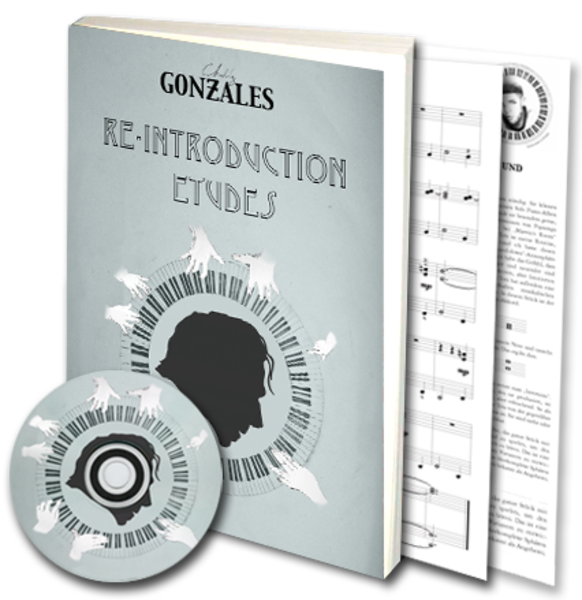 « Showing off is BORING. » – Chilly Gonzales, Re-Introduction Etudes
« Showing off is BORING. » – Chilly Gonzales, Re-Introduction Etudes
In the 60s, Sammy Davis Jr. recorded a series of intimate performances for the BBC, which they recently re-ran. Sammy danced, told stories and jokes, performed impressions, demonstrated expert gunplay, and (above all else), sang with the warmth of an old friend. With all of his showmanship, not once do you ever feel that he’s showing off – quite the opposite – you have the sense that he’s performing for the audience and nothing else. Instead of Sammy walking onstage and proclaiming, « Here I am! » it’s as if he walks out and says, « I’m so glad you’re here! »
After a long solo performance of 6 Bach Cello suites, Yo-Yo Ma was asked if he had any pre-concert jitters. He said that he wasn’t nervous because, « It’s not about proving anything. It’s about sharing something. » That feeling of sharing also connects Gonzales with his audience. When Gonzales walks out to warm applause in concert, he broadly smiles, waves and heads directly for the piano bench without saying a word. As Gonzales plays, he channels feelings and emotion though an instrument – something that is inherently more difficult than singing and telling jokes (although he does those eventually as well). Through his notebooks, Gonzales shares his love for music, but Re-Introduction Etudes exemplifies his innate sense of sharing and teaching. In a recent Walrus article, (« Piano Man« ) Gonzales discusses elements of music and music education that face students and educators today.
The article’s author examines Gonzales’ recent foray into broader musical education with one of his Re-Introduction Etudes classes in Toronto (see our post and review of the Montreal lecture). Gonzales shares his experience with musical education as a young boy in Montreal, then again as a high school student in Toronto. He also shares his vision for musical education, namely to divert a portion of funds earmarked for artists (via grants) to schools for music education. Also explored is the notion of using actively performing musicians as educators, since musicians could deconstruct modern music and make music theory more accessible to students.
The article also features a brief discussion about The Royal Conservatory of Music (RCM), which is a Canadian musical institution founded in 1886, with the goal of developing art and music education. Recently, the RCM study and examination books changed their piece selection method, from inaccessible old (as in centuries old) songs, to a mixture of wonderfully playful and unique pieces, combined with standards that impart specific techniques. As proof of this change of heart, the article mentions that one of the notebooks contains a Gonzales waltz – the elegant Carnivalse (a play on ‘Carnivals’ and the French word for ‘Waltz’ – ‘Valse’).
There’s a certain ‘feeling’ to Gonzales’ compositions (such as Carnivalse), which is akin to a Kubrick movie – there is a great amount of detail contained within the content, but it is so expertly executed that we feel it more than see (or hear) it. For solo piano, those details are in the choice of key, harmony, bass line, flourishes, trills, upright piano, half-pedaling, sourdine, and so on. Those details are vital, as the piano doesn’t have many dynamic elements such as vibrato to make that emotional connection with the audience. Gonzales discusses many ‘dynamic’ techniques in Re-Introduction Etudes in a manner that is fun to play and learn for modern ears. The ‘modern ear’ aspect is important, since a student raised on EDM will hardly be able to connect to the likes of Mendelssohn, but won’t have any issues with Knight Moves. Actually, all of Gonzales’ notebooks can be used in some way for education, as there are many sections that can be used for things like finger strengthening and other techniques – even for absolute beginners. Gonzales has made 6 videos available from his lessons on Re-Introduction Etudes:
The Walrus article concludes with Gonzales reminiscing about his time at a high-end clothing shop in Toronto. In a previous concert in Toronto (the one that Drake attended), Gonzales explained how he used to play in ‘Andrews’, which is an clothing store in the Yorkville area of Toronto. There, he would spend hours entertaining customers while simultaneously honing his piano skills. He explained to the audience, « If a lady wearing a red dress walked into the store, all of a sudden, I would start to play Lady in Red. » The world of business is just now moving to the notion of an ‘audience of one’ – in other words, you want to create a personalized experience for every customer who accesses your services. Gonzales is way ahead of the curve in that regard, as his music creates a unique and personal experience in every listener. His willingness to share his knowledge (musical and otherwise) and his belief in people young and old to take up the piano and find joy in expressing themselves is a wonderful and refreshing notion.
The article’s title may have been a nod to Billy Joel’s signature song Piano Man, where Billy’s hotel bar performer persona finds down-and-out patrons asking him to, « Sing us a song, you’re the Piano Man ». Gonzales’ version is slightly different. He finds an eager and willing audience making a completely different request, « Teach us to play, Chilly Gonzales, you’re the Piano Man. »
